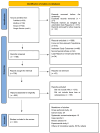Bone Loss and Fractures in Post-Menopausal Women Living with HIV: A Narrative Review
- PMID: 39339002
- PMCID: PMC11435029
- DOI: 10.3390/pathogens13090811
Bone Loss and Fractures in Post-Menopausal Women Living with HIV: A Narrative Review
Abstract
Introduction: Post-menopausal women living with Human Immunodeficiency Virus (WLHIV) face an increased risk of bone fractures due to the relationship between HIV-related factors and menopause. This narrative review aims to summarise the current knowledge about fracture risk among post-menopausal WLHIV in particular looking at hormonal changes, combined antiretroviral therapy (cART), lifestyle factors, and psychosocial implications. We also profiled a summary of the significant, recent studies of post-menopausal WLHIV residing in low-income countries (LIC).
Methods: A thorough search of the literature was performed across PubMed, Medline, Scopus, and Google Scholar, focussing on studies published between 2000 and 2024. Inclusion criteria entailed original research, reviews, and meta-analyses addressing bone mineral density (BMD), fracture incidence, and related risk factors in post-menopausal WLHIV.
Results: The review identified 223 relevant studies. Post-menopausal WLHIV exhibit significantly lower BMD and higher fracture rates compared to both HIV-negative post-menopausal women and pre-menopausal WLHIV. cART, particularly tenofovir disoproxil fumarate (TDF), contributes to reduced BMD. Menopausal status exacerbates this risk through decreased oestrogen levels, leading to increased bone resorption. Moreover, lifestyle choices such as smoking, alcohol consumption, and low physical activity are more prevalent in PWHIV, which further elevates fracture risk. Different psychosocial factors may make WLWHIV more vulnerable at this stage of their life, such as depression, isolation, stigma, and housing and nutritional issues. Women living in LICs face a variety of challenges in accessing HIV care. There are gaps in research related to the prevalence of osteoporosis and bone loss in post-menopausal WLHIV in LICs.
Conclusion: Post-menopausal women living with HIV face a significantly higher risk of bone loss and fractures due to the combined effects of HIV and menopause. Antiretroviral therapy (particularly TDF), lifestyle factors, and psychosocial challenges exacerbate this risk. There is a need for careful selection of cART, hormone replacement therapy (HRT), and emerging treatments such as Abaloparatide. A holistic approach including lifestyle changes and psychosocial support is crucial to reduce fracture risk in WLHIV, especially in low-income countries.
Keywords: bone loss; fractures; living with HIV; post-menopausal; women.
Conflict of interest statement
The authors declare no conflict of interest.
Figures


Similar articles
-
Osteoporosis in postmenopausal women living with HIV.Maturitas. 2017 Jan;95:50-54. doi: 10.1016/j.maturitas.2016.10.015. Epub 2016 Nov 5. Maturitas. 2017. PMID: 27889053 Free PMC article. Review.
-
Prevalence of HIV-associated osteoporosis and fracture risk in midlife women: a cross-sectional study in Zimbabwe.J Bone Miner Res. 2024 Sep 26;39(10):1464-1473. doi: 10.1093/jbmr/zjae138. J Bone Miner Res. 2024. PMID: 39180721 Free PMC article.
-
The burden of menstrual irregularities among women living with HIV in Nigeria: a comprehensive review.Reprod Health. 2024 Nov 3;21(1):156. doi: 10.1186/s12978-024-01892-0. Reprod Health. 2024. PMID: 39491003 Free PMC article. Review.
-
Osteoporosis-Related Fractures in HIV-Infected Patients Receiving Long-Term Tenofovir Disoproxil Fumarate: An Observational Cohort Study.Drug Saf. 2018 Sep;41(9):843-848. doi: 10.1007/s40264-018-0665-z. Drug Saf. 2018. PMID: 29623648 Free PMC article.
-
Low BMD is an independent predictor of fracture and early menopause of mortality in post-menopausal women--a 34-year prospective study.Maturitas. 2013 Apr;74(4):341-5. doi: 10.1016/j.maturitas.2013.01.002. Epub 2013 Jan 29. Maturitas. 2013. PMID: 23374709
Cited by
-
Narrative Review on the Management of Neck of Femur Fractures in People Living with HIV: Challenges, Complications, and Long-Term Outcomes.Microorganisms. 2025 Jun 30;13(7):1530. doi: 10.3390/microorganisms13071530. Microorganisms. 2025. PMID: 40732042 Free PMC article. Review.
-
Alcohol Use and Its Associations With Frailty, Fractures, and Falls Among Older Adults With HIV.Alcohol Res. 2025 Aug 8;45(1):08. doi: 10.35946/arcr.v45.1.08. eCollection 2025. Alcohol Res. 2025. PMID: 40792193 Free PMC article. Review.
References
-
- UNAIDS . Global HIV and AIDS Statistics—Fact Sheet. UNAIDS; Geneva, Switzerland: 2024. [(accessed on 17 August 2024)]. Available online: https://www.unaids.org/sites/default/files/media_asset/UNAIDS_FactSheet_....
Publication types
MeSH terms
LinkOut - more resources
Full Text Sources
Medical

